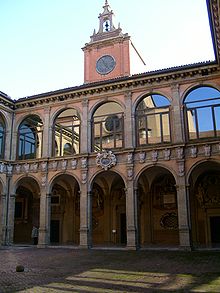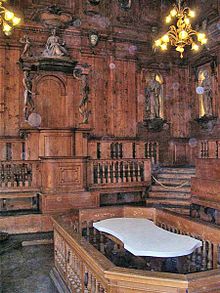Palazzo dell'Archiginnasio
The Palazzo dell'Archiginnasio is a palatial building in the Italian city of Bologna . After its completion in 1563, it became the first permanent seat of the University of Bologna, which had existed since the 11th century, and now houses the Biblioteca Comunale dell'Archiginnasio , the city library of Bologna. The building is located in the center on Piazza Galvani.
University building from 1563 to 1803
In the 16th century, the area around Piazza Maggiore was radically renewed by order of Pope Pius IV . At the same time the Neptune Fountain was built. The Pope commissioned Cardinal Karl Borromeo as papal legate and Pier Donato Cesi as vice-delegate with the construction of the Archiginnasio. They passed the order on to the architect Antonio Morandi (called "il Terribilia"). The construction work was carried out from 1562 to 1563.
The building was planned as a central university building and was intended to replace the classrooms that were previously scattered across the city. Archiginnasio's palace housed the University of Bologna from 1563 to 1803 and is rich in evidence of university life for three centuries. What is remarkable is the large number of coats of arms and inscriptions from students and teachers that have been affixed to many walls, vaults and stairwells over the years.
The building is divided into two floors, has a porch with an inner courtyard that includes the former church of Santa Maria dei Bulgari . On the upper floor were the study rooms for law and the arts. Their corresponding large lecture halls are the Sala dello Stabat Mater (Stabat Mater Hall) and today's Sala di Lettura (reading room) of today's city library. A huge coat of arms fresco (with 6000 coats of arms of the students and inscriptions in honor of the professors), which has been preserved despite the destruction ordered by the Republican government in 1797 and the bombing in World War II , adorns the vault on the lower floor.
On the upper floor is the Teatro anatomico ( anatomical theater ), built according to the design by Antonio Levanti in 1637 . It was constructed as a teaching facility for anatomical sections in the shape of an amphitheater, lined with fir wood and decorated with a coffered ceiling and statues. The hall collapsed in the bombings in 1944 and was later rebuilt.
City library since 1838
The Biblioteca Comunale dell'Archiginnasio (City Library) dates back to 1801 and was originally housed in the Monastery of San Domenico. It was moved from there to the Archiginnasio's palace in 1838 and has been housed here ever since. The collected documents deal with various subjects, including mainly history, philosophy, politics, literature, art, biography and bibliography, as well as a rich section on the culture of the city of Bologna.
Today the library has over 850,000 volumes and notebooks, 25,000 letters from celebrities and 12,000 manuscripts. These include around 2,500 incunabula from the 16th century and 120,000 works published before 1830.
Stabat Mater Hall
This hall got its name after the Italian premiere of the piece Stabat Mater for solo quartet, choir and orchestra by Gioachino Rossini under the baton of Gaetano Donizetti took place there on March 18, 1842 .
Memorial inscription in honor of Carlo Borromeo
See also
Web links
- Biblioteca comunale dell'Archiginnasio - Bologna
- Le raccolte digitali della Biblioteca dell'Archiginnasio
Individual evidence
- ^ Biblioteca comunale dell'Archiginnasio - Bologna. Retrieved November 15, 2019 .
- ↑ http://www.archiginnasio.it/stabat.htm
Coordinates: 44 ° 29 ′ 31.8 " N , 11 ° 20 ′ 36.6" E





